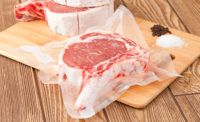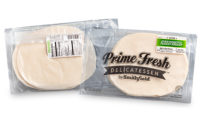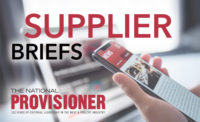We’ve come a long way since John Glenn ate the first applesauce packed in a tube in zero-gravity atmosphere during the NASA Friendship 7 flight in 1962. Today, we only need to travel down the aisles of our favorite stores to see flexible packaging revolutionizing the way we package, store and ship our food (and it tastes better than the pureed beef and vegetables of early space travel). Mothers are feeding their babies food from squeezable pouches that eliminate the need for spoons, bowls and even bibs. Our crackers and cookies come in resealable pouches that protect and keep them fresher longer. Frozen veggies can be steamed in the microwave right in their bags, and our salads stay crisp for days in bags that feature venting technology. And we can enjoy all of this within the earth’s atmosphere.
Continued, rapid growth
It’s no surprise that with flexible packaging’s steady technological progression, the industry continues to experience tremendous growth. In fact, flexible packaging is one of the fastest growing packaging segments. The total U.S. flexible packaging industry is estimated to have been about $31 billion in annual sales and 18.1 billion pounds of material in 2015. Representing approximately 19% of the total $163 billion U.S. packaging industry, flexible packaging is the largest packaging segment behind corrugated paper. Growth will continue to be driven by the value, convenience and sustainability benefits only flexible packaging can offer.
Unparalleled brand value, convenience
As evidenced by the rise in snacking that has contributed to the growth of single-serve and resealable flexible packaging, consumers seek products and packaging that deliver convenience for their fast-paced lives. In a recent Flexible Packaging Association (FPA) survey of 2,120 consumers conducted by Harris Poll, consumers placed high value on packaging that is “easy to store,” “easy to reseal” and “easy to open.”
Consumers in the survey also said they are willing to pay more for benefits like “ability to reseal,” “ability to extend product life,” “easy to store” and “easy to open.”
Brand owners are responding to the need for convenience by strategically matching their products with packaging that fits today’s consumer lifestyles.
A great example is FPA’s 2016 highest achievement award winner, Campbell’s Ready Meals self-venting retort pouch, which is microwave friendly and has an easy-open tear that creates an instant bowl so consumers can eat right out of the pouch with easy cleanup. Another FPA achievement award winner, Fresh N Tasty® also tailored their packaging to meet customers’ needs by developing flexible packaging with stay-fresh barrier properties, so baked goods still taste like they’re fresh from the bakery days later.
Sustainability, food waste solutions
Flexible packaging is also the most sustainable option. Flexible packaging makes everyday products more resource-efficient by using less packaging and lowering overall environmental impact. Compared to alternative packaging types, flexible packaging helps reduce CO2 emissions and fuel consumption. For instance, it takes 26 truckloads of unfilled glass jars compared to one truckload of unfilled flexible pouches to transport packaging for equal amounts of product.
A favorable product-to-package ratio makes flexible packaging both the environmentally and fiscally responsible option. To package 60 pounds of beverage, it takes 50 pounds of glass, 6 pounds of rigid PET and 3 pounds of aluminum. This is compared to the 1.5 pounds of flexible plastic needed for the same amount of beverage.
Flexible packaging also contributes to lowering food waste. In the U.S., 40% of all edible food is wasted, making up to about 14.6% of the total U.S. Municipal Solid Waste (MSW) stream. This not only impacts the environment but also consumers’ wallets. The average American throws away $28-43 in the form of about 20 pounds of food each month. Wasting 15% less food would save enough to feed 25 million Americans.
Flexible packaging extends shelf life, in turn reducing food waste. Innovations like modified atmosphere packaging, vacuum packaging, active packaging and retort packaging help seal in freshness and lock out potentially damaging environmental elements, helping keep food fresher longer. Flexible packaging can increase shelf life of a bell pepper from four days to 20 days, ground beef from three days to 20 days, and a whole chicken from seven days to 20 days. The resealable and single-serve/portioned features of flexible packaging formats also help provide a much-needed solution to America’s ongoing food waste problem.
Flexible packaging manufacturers continue to make their packaging even more sustainable. For example, FPA achievement award winner Berry Plastics Corporation designed Cowboy Bath packaging from a reverse-printed trapped ink configuration to surface printed flexograph by using a UV curing ink system. This process eliminated one of the film layers to the design, reducing waste while also reducing manufacturing costs.
Complex challenges, innovative solutions
The flexible packaging industry continues to make considerable strides toward developing new materials, machinery and film technologies that enhance its benefits. Material advancements including increased barrier properties, innovated laminations and coextrusions enable flexible packaging manufacturers to tailor their packaging to a specific product or need. Machinery advancements help the industry reach new levels of functionality – such as the ability to fill packages faster – which also contribute to film innovation advancements.
The flexible packaging industry will continue to innovate; machinery will get faster, films will get thinner and protect products better, and the overall package will work to keep products fresher longer. This will position flexible packaging to experience progressive growth as consumers continue to demand sustainable packaging that fits their on-the-go lifestyles. NP





Report Abusive Comment